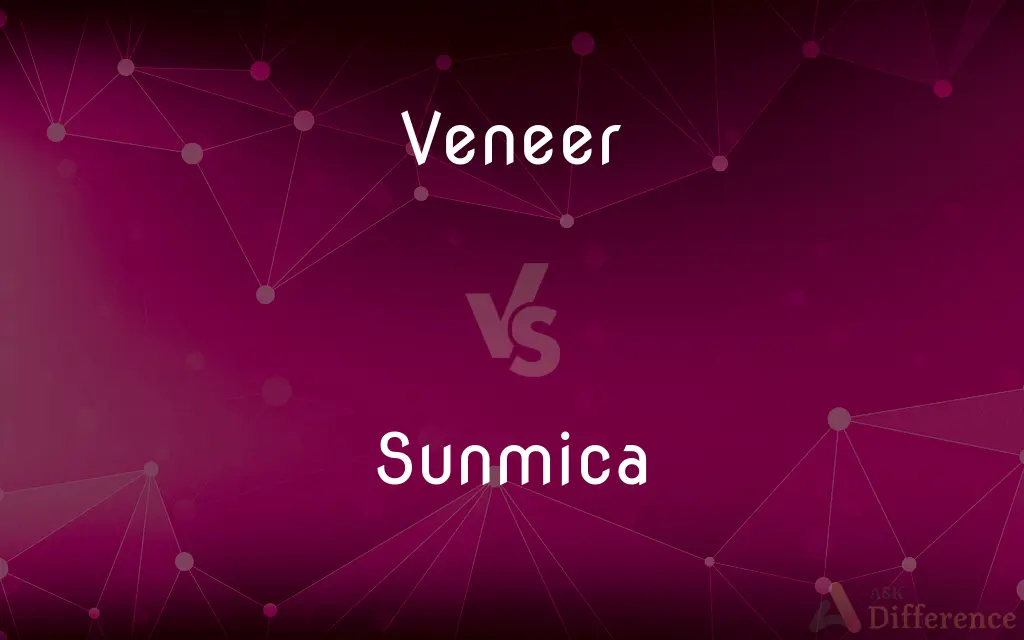Veneer vs. Sunmica — What's the Difference?
By Tayyaba Rehman — Published on December 2, 2023
Veneer is a thin layer of real wood glued to a substrate, providing a natural wood finish. Sunmica, a brand of laminate, is a decorative overlay made of layers of paper and resin, offering diverse designs.

Difference Between Veneer and Sunmica
Table of Contents
ADVERTISEMENT
Key Differences
Veneer and Sunmica are both popular materials used to beautify surfaces, but they come with distinct characteristics and purposes. Veneer refers to thin slices of wood obtained from a tree trunk. These thin slices, showcasing genuine wood patterns, are glued to a substrate, such as particle board or MDF, giving surfaces a rich and authentic wooden appearance. Sunmica, on the other hand, is a brand that has become synonymous with laminates. Made up of layers of paper infused with melamine resin, Sunmica provides a hard, scratch-resistant surface ideal for various applications.
When considering aesthetics, Veneer takes the advantage of offering the natural charm of wood. The unique patterns, colors, and textures available in different wood types give Veneer its allure. Sunmica, though lacking the natural touch of wood, compensates by offering a multitude of design choices. From mimicking natural materials like wood and stone to abstract patterns, Sunmica provides a versatile design palette to cater to different tastes.
In terms of durability and maintenance, Veneer requires more care as it's sensitive to environmental changes and can be affected by moisture. It often needs polishing to retain its sheen. Sunmica, being a synthetic product, boasts of high durability and is easier to maintain, making it suitable for areas exposed to wear and tear.
Lastly, when discussing cost, Veneers tend to be more expensive due to their natural wood composition. They bring the luxury of real wood to interiors. Sunmica, being a manufactured product, generally comes at a more affordable price point, allowing for broader application in both residential and commercial spaces.
Comparison Chart
Material
Thin slices of real wood.
Layers of paper infused with melamine resin.
ADVERTISEMENT
Aesthetic Appeal
Offers natural wood patterns.
Provides diverse designs, including imitation patterns.
Durability & Maintenance
Sensitive to moisture, requires regular care.
Highly durable, low maintenance.
Cost
Generally more expensive.
Typically more affordable.
Usage
Luxury interiors, furniture.
Residential and commercial interiors, furniture.
Compare with Definitions
Veneer
A thin slice of wood glued to a substrate for decorative purposes.
The dining table had a walnut veneer that added richness to its appearance.
Sunmica
A brand of laminate used for decorative surfacing.
I chose a marble-patterned Sunmica for my kitchen countertop.
Veneer
A material used to give an object a more attractive surface.
The veneer on the cabinet made it a centerpiece of the room.
Sunmica
A choice for those seeking cost-effective and durable decorative solutions.
Considering our budget, we opted for Sunmica over other pricier materials.
Veneer
A surface layer representing a superior material.
The veneer on the plywood made it look like an expensive piece.
Sunmica
A commonly used term in India for laminates, derived from the brand name.
My neighbor recommended using Sunmica for the wardrobe doors.
Veneer
A thin surface layer, as of finely grained wood, glued to a base of inferior material.
Sunmica
A decorative overlay for interiors and furniture.
The vibrant Sunmica design added a modern touch to the room.
Veneer
Any of the thin layers glued together to make plywood.
Sunmica
A synthetic material known for its durability and design versatility.
We used Sunmica on the cupboards since it's resistant to wear and tear.
Veneer
A decorative facing, as of brick.
Veneer
A deceptive, superficial show; a façade
A veneer of friendliness.
Veneer
To overlay (a surface) with a thin layer of a fine or decorative material.
Veneer
To glue together (layers of wood) to make plywood.
Veneer
To conceal, as something common or crude, with a deceptively attractive outward show.
Veneer
A thin decorative covering of fine material (usually wood) applied to coarser wood or other material.
Veneer
An attractive appearance that covers or disguises one's true nature or feelings.
Veneer
To apply veneer to.
To veneer a piece of furniture with mahogany
Veneer
To disguise with apparent goodness.
Veneer
To overlay or plate with a thin layer of wood or other material for outer finish or decoration; as, to veneer a piece of furniture with mahogany. Used also figuratively.
As a rogue in grainVeneered with sanctimonious theory.
Veneer
A thin leaf or layer of a more valuable or beautiful material for overlaying an inferior one, especially such a thin leaf of wood to be glued to a cheaper wood; hence, external show; gloss; false pretense.
Veneer
Coating consisting of a thin layer of superior wood glued to a base of inferior wood
Veneer
An ornamental coating to a building
Veneer
Cover with veneer;
Veneer the furniture to protect it
Veneer
A façade or appearance, often to disguise something's true nature.
His charm was merely a veneer hiding his true intentions.
Veneer
Thin sheets of wood used to produce layers of plywood.
Manufacturers use multiple veneers to create sturdy plywood.
Common Curiosities
Can I get a wood look with Sunmica?
Yes, Sunmica offers designs that mimic natural wood patterns.
Which is more expensive, Veneer or Sunmica?
Veneer is generally more expensive due to its natural wood composition.
Is Sunmica a brand or a type of material?
Sunmica is a brand, but it has become synonymous with laminates in some regions.
Can Veneer be used in high moisture areas?
Veneer is sensitive to moisture, so it's not recommended for high moisture areas.
How is Veneer attached to surfaces?
Veneer is typically glued to a substrate, such as particle board or MDF.
Does Veneer fade over time?
Prolonged exposure to sunlight can cause some Veneers to fade or change color.
What is Veneer made of?
Veneer is made of thin slices of real wood.
Does Veneer offer the same durability as Sunmica?
Veneer, being natural wood, requires more care and can be affected by moisture, while Sunmica is more durable and resistant.
How many design choices does Sunmica offer?
Sunmica offers a wide range of designs, from natural imitations to abstract patterns.
Are Veneers eco-friendly?
Veneers use less wood compared to solid wood, making it a more sustainable choice, but sourcing and sustainability practices vary.
Can I get Sunmica customized to my design?
While Sunmica offers a wide range of designs, custom designs might be limited or require special orders.
How thick is a standard Sunmica sheet?
Sunmica sheets typically range from 0.6mm to 1.5mm in thickness.
Is Sunmica resistant to scratches?
Yes, Sunmica is known for its scratch-resistant properties.
What maintenance does a Veneer surface require?
Veneer may need polishing and protection from environmental factors to retain its sheen.
How do I clean Sunmica surfaces?
Sunmica can be cleaned with a damp cloth and mild detergent, avoiding abrasive scrubs.
Share Your Discovery

Previous Comparison
Logical Address in Operating System vs. Physical Address in Operating System
Next Comparison
VXX vs. VIXAuthor Spotlight
Written by
Tayyaba RehmanTayyaba Rehman is a distinguished writer, currently serving as a primary contributor to askdifference.com. As a researcher in semantics and etymology, Tayyaba's passion for the complexity of languages and their distinctions has found a perfect home on the platform. Tayyaba delves into the intricacies of language, distinguishing between commonly confused words and phrases, thereby providing clarity for readers worldwide.














































